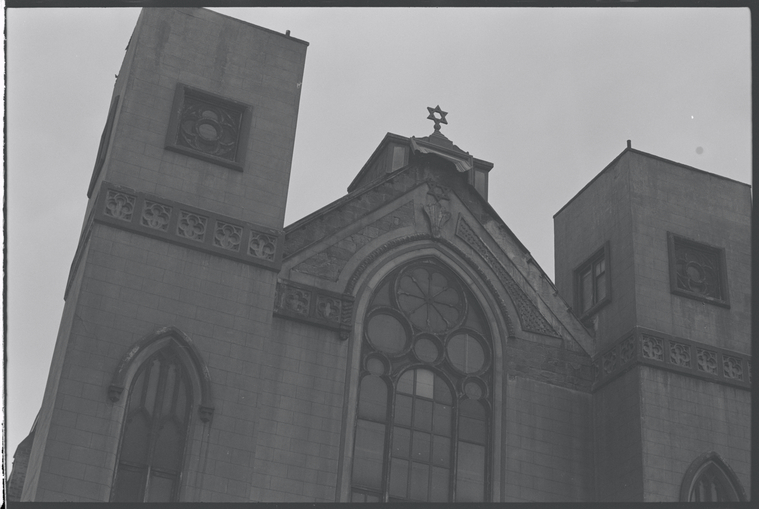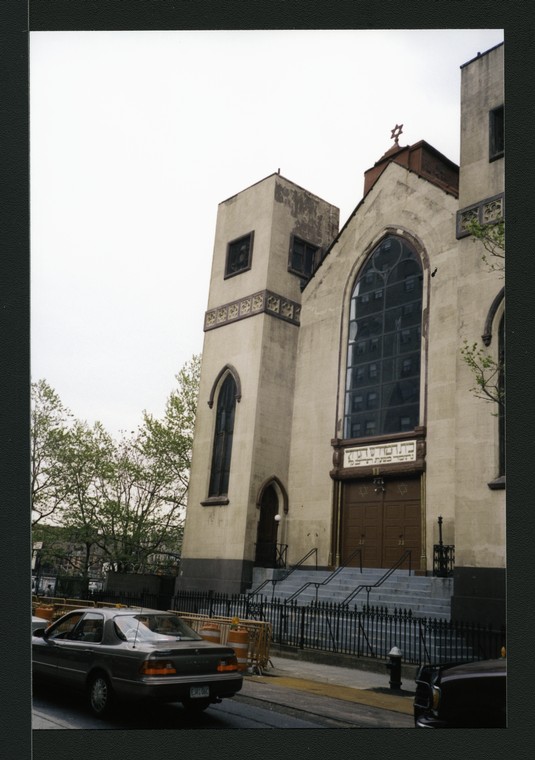NYC Neighborhoods
Lower East Side Story: Beth Hamedrash Hagodol
On May 14, the storied Lower East Side synagogue, Beth Hamedrash Hagodol (BHH)*, suffered an explosion, destroying much of the structure in a matter of hours. The Library has a number of items that highlight the development and presence of synagogues in New York City, including at least one photographic collection wherein Beth Hamedrash Hagodol features prominently. This post pays tribute to the building, with a short history, and a view back to better days.
60 Norfolk Street
Part of James Delancey's farmland in colonial New York, one could argue that 60 Norfolk Street's history began with fire: a Baptist congregation purchased the property after their church on the same block was destroyed in an 1848 blaze. Two years later, when the Norfolk Street Baptist Church's new Gothic Revival style sanctuary was dedicated there, the New-York Evangelist declared it "one of the most beautiful and imposing architectural objects in the city."
The Baptist congregation relocated within a decade, and the building was home to, in succession, the Alanson Methodist Episcopal Church, and the New York City Church Extension and Missionary Society of the Methodist Episcopal Church, before the structure was finally purchased by Congregation Beth Hamedrash Hagodol (Great House of Study), the "oldest congregation in America established by Russian Orthodox Jewish immigrants," in 1885.

Digital ID 1992710
The New York Public Library
The building was adapted, to suit the needs of its Orthodox congregation, and the synagogue served a rapidly expanding community (an estimated 500,000 Eastern European Jews moved to America in the last two decades of the nineteenth century, and many settled on the Lower East Side). In City of Promises, Annie Polland and Daniel Soyer observed:
Beth Hamedrash Hagadol, perhaps the largest eastern European congregation (which, along with Kahal Adath Jeshurun, could trace its roots to Beth Hamedrash, the Russian congregation that formed in 1852 in Five Points), took the eastern European synagogue to a new level when it purchased a church on Norfolk Street and renovated it into a handsome synagogue.
Indeed, BHH quickly grew in reputation, as well. Noted Andrew Dolkart: "Beth Hamedrash Hagodol became an increasingly important presence on the Jewish Lower East Side. The prominence of the congregation peaked in 1889 when New York's first and only chief rabbi, Jacob Joseph, became rabbi of the synagogue. … This added prestige to the congregation…"
Over time, the population of the Lower East Side shifted demographically, but Beth Hamedrash Hagodol consistently maintained a congregation. Threatened with calls for its demolition in the twentieth century, the building was designated a New York City landmark in 1967, and added to the National Register of Historic Places in 1999, recognized for its historical and architectural significance.
 Fire affected the property again in 2001, leaving Beth Hamedrash Hagodol with damaged interior spaces. By 2007, with its congregation dwindling to fewer than 20 members meeting in a structure of questionable safety, BHH Rabbi Mendi Greenbaum closed the structure permanently. In 2012, Greenbaum and synagogue leadership submitted a so-called hardship application (used by owners in New York City who claim upkeep of their properties within the provisions of the laws would constitute a financial hardship) to the New York City Landmarks Preservation Commission, and requested permission to demolish the structure. The application was withdrawn, but as real estate development in the surrounding area transformed from the mostly vacant Seward Park Urban Renewal Area (SPURA) into "Essex Crossing", local residents raised a collective eyebrow, concerned about BHH's motivations and willingness to protect the historical structure. The fire on May 14 devastated the building, and with it, hopes for its continued preservation.
Fire affected the property again in 2001, leaving Beth Hamedrash Hagodol with damaged interior spaces. By 2007, with its congregation dwindling to fewer than 20 members meeting in a structure of questionable safety, BHH Rabbi Mendi Greenbaum closed the structure permanently. In 2012, Greenbaum and synagogue leadership submitted a so-called hardship application (used by owners in New York City who claim upkeep of their properties within the provisions of the laws would constitute a financial hardship) to the New York City Landmarks Preservation Commission, and requested permission to demolish the structure. The application was withdrawn, but as real estate development in the surrounding area transformed from the mostly vacant Seward Park Urban Renewal Area (SPURA) into "Essex Crossing", local residents raised a collective eyebrow, concerned about BHH's motivations and willingness to protect the historical structure. The fire on May 14 devastated the building, and with it, hopes for its continued preservation.
A multifaceted landmark
When the building came before the Landmarks Preservation Commission (LPC) for nomination fifty years ago, the Building had already achieved informal recognition:
"This great Synagogue has long been considered a landmark by the Greater New York Board of Rabbis, by the Union of Orthodox Congregations of the United States representing three thousand congregations and by the citizens of the community."
And BHH was an unconventional landmark: the architecture was significant, but secondary to the role the synagogue - and its congregations - played in the history and development of New York City. At a time when structures were recognized largely for their aesthetics, BHH was landmarks for representing the history of the city and its religious institutions.
Out of the ashes?
Somewhat ominously, as of May 18, New York State's Cultural Resource Information System (CRIS) lists the property as "Demolished/destroyed by fire 5/14/2017", and Google Maps no longer includes a site label for the address, though the building outline remains. Certainly, acknowledged urban historian Allison Siegel, there are challenges ahead, but the miraculous is also possible: apparently, the institution's library survived the inferno, something many librarians would argue, is reason enough for hope.

1933. (detail) Digital ID 721939f
The New York Public Library
Further Reading
The New York City Landmarks Preservation Commission report, available free online, includes a description of the building's architectural features, and a brief history of the structure.
And you can read the original National Register of Historic Places nomination form online via New York State's Cultural Resource Information System (CRIS) (you must login as a guest to search property reports).
New York Public Library's Art & Architecture Division has a number of materials pertaining to the history of synagogue architecture and the Gothic Revival in the United States and elsewhere; the Dorot Jewish Division holds over 140 titles on global synagogue architecture as well as a number of items on the Lower East Side and its history; and the Miriam and Ira D. Wallach Division's Morris Huberland Collection includes over 250 images of synagogues in New York City.
See also the Library's Digital Collections for additional images of synagogues in New York City, including Milstein's Photographic Views of New York City, 1870s-1970s and images by Percy Loomis Sperr, and Dylan Stone's photographs of Block 266 in 1999, as well as maps of the Lower East Side, that chart the days before, during, and after 60 Norfolk Street was sanctified as Beth Hamedrash Hagodol.
Search the Library's online catalog:
Cited in this post:
City of Promises, volume 2: Emerging metropolis: New York Jews in the age of immigration, 1840-1920, by Annie Polland and Daniel Soyer (also online via ProjectMuse)
DNA Info New York and BoweryBoogie.com coverage of the building, past and present, as well as photographs of the interior spaces from the New York Landmarks Conservancy
The New-York Evangelist, January 24, 1850: 14.
Judah Eisenstein, "The History of the First Russian-American Jewish Congregation: The Beth Hamedrash Hagodol," Publications of the American Jewish Historical Society.9 (1901): 63–74.
*There are two spellings of "Hagodol" in the literature regarding this building. This post uses the spelling conventions observed by the New York City Landmarks Preservation Commission and National Register of Historic Places listings.
Read E-Books with SimplyE
 With your library card, it's easier than ever to choose from more than 300,000 e-books on SimplyE, The New York Public Library's free e-reader app. Gain access to digital resources for all ages, including e-books, audiobooks, databases, and more.
With your library card, it's easier than ever to choose from more than 300,000 e-books on SimplyE, The New York Public Library's free e-reader app. Gain access to digital resources for all ages, including e-books, audiobooks, databases, and more.
If you don’t have an NYPL library card, New York State residents can apply for a digital card online or through SimplyE (available on the App Store or Google Play).
Need more help? Read our guide to using SimplyE.

